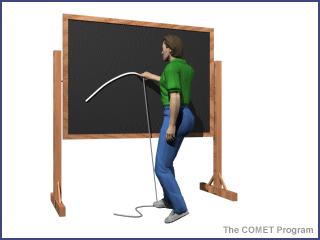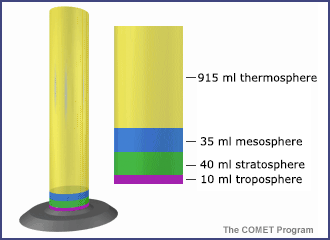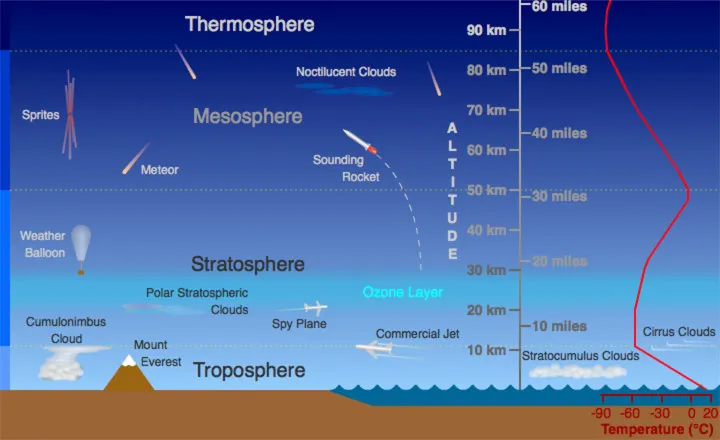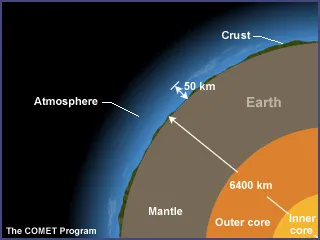Demonstrating the Thickness of Atmospheric Layers
Students will observe scale models of the atmosphere and its layers in this two-part activity. Students will learn about the height of Earth's atmosphere as compared to the size of the planet overall. In part two, they will also learn about the relative thickness of each of the four main layers of the atmosphere.
Learning Objectives
- Students will be able to explain how relatively thin the atmosphere is, compared to the size of Earth.
- Students will understand the relative extent (thickness) of the four major atmospheric layers.
Materials
For class demo:
- Chalkboard or dry erase board mounted on a wall
- Chalk or dry erase marker
- 2-meter piece of string
- An apple
- 1000 mL(1 liter) graduated cylinder
- Four bags of fish gravel or colored sand (different colors)
Directions
- Introduction
- Tell students that they are going to use a model to explore how far the Earth's atmosphere extends above the surface of the Earth and will learn about the thickness of the different layers of the atmosphere.
- Ask students "How far do you think the atmosphere extends above us?"
-
Tie a dry eraser marker or a piece of chalk to one end of the string. Standing next to theboard, place your foot on the free end of the string and draw an arc on the board with a radius of about 4 feet. Your foot represents the center of the Earth. The arc represents the surface of the Earth.

- Ask students to suggest how far the Earth's atmosphere would extend above the surface in this drawing. Mark their suggestions on the board above the chalk/markerline.
- Tell the students that scientists have found that over 90% of the Earth's atmosphere is within about seven miles (12 km) of the Earth's surface. The distance from the center of the Earth to its surface equals about 4,000 miles. The scale of the chalkboard drawing is about 1 foot = 1,000 miles (1,610 km). So, on this scale, seven miles is a little less than 1/8th of an inch (about as thick as the chalk line), and 90% of the Earth's atmosphere lies within the thickness of the chalk line used to draw the surface of the Earth.
- Another way of understanding how far out the atmosphere extends is to imagine that the Earth has shrunk to the size of an apple. At that scale, the atmosphere is only the thickness of the skin of the apple. Use an apple for a demonstration.
- Tell students that they are going to help build a model of the structure of the atmospheric layers to understand thethicknessof each of the four layers of the atmosphere (troposphere, stratosphere, mesosphere, thermosphere).
- Use a 1000 mL (1 liter) graduated cylinder and represent the layers by using the following amounts of fish gravel or colored sand found in the photo and table below. Students can choose what color they want for each atmospheric layer. Keep in mind these are relative proportions and not exact points of departure for the different layers. In this scale model, each millileter of volume represents one kilometer of atmosphere layer thickness (for example, the troposphere is 10 km thick and is represented by 10 ml of sand or gravel in the graduated cylinder).

| Atmospheric Layer | Color Code | Thickness | Top of Layer |
| Troposphere | Color 1 | 10 mL | 10 |
| Stratosphere | Color 2 | 40 mL | 50 |
| Mesosphere | Color 3 | 35 mL | 85 |
| Thermosphere | Color 4 | 915 mL | 1000 |
Observations and Questions
- What atmospheric layers are represented by the different colors?(Answer: Depends on what colors students choose)
- What atmospheric layer do we live in? (Answer: We live in the troposphere.)
- How much thicker is the stratosphere compared to the troposphere? (Answer: 30 km which is 45 km - 10 km)
- How much thicker is the thermosphere compared to all the other layers combined? (Answer: 830 km = 915 km - [10 km + 40 km + 35 km])
- Where in this model would you expect to find clouds? (Answer: Troposphere)
- Where in this model would you expect to find Mt. Everest? (Answer: Troposphere)
- Where in this model would you expect to find a satellite? (Answer: Thermosphere)
- Where in this model would you expect to find the space shuttle? (Answer: Thermosphere)
- Where in this model is the ozone layer? (Answer: Stratosphere)
Assessment
- Use the apple question suggested in the procedure and have students respond in writing or with a picture instead of simply orally in class. Think of the apple as the size of the Earth and the skin of the apple represents the thickness of the atmosphere.
- Have students make a labeled diagram on a small notecard illustrating the most important point of the lesson.
- Ask students to imagine that they're in orbit around a planet one half the size and mass of the Earth, but otherwise identical. They should explain how they would expect the atmosphere of the new planet to be different from ours.
Background
Earth's atmosphere has layers, each with its own specific traits. Moving upward from ground level, these layers are named the troposphere, stratosphere, mesosphere, and thermosphere. Some scientists also count the exosphere, the faint uppermost reaches of the atmosphere that gradually fades into space, as a fifth layer... however, the exosphere is not included in this activity.

Layers of the atmosphere: troposphere, stratosphere, mesosphere and thermosphere.
UCAR/Randy Russell
This activity demonstrates the relative thickness of the thin section of the atmosphere that includes the troposphere and stratosphere. These layers are essential to all life on Earth.
Over 99% of the mass of the Earth's atmosphere is contained in the two lowest layers: the troposphere and the stratosphere. Most of the Earth's atmosphere (80 to 90%) is found in the troposphere, the atmospheric layer where we live. This layer, where the Earth's weather occurs, is within about 10 km (6 miles) of the Earth's surface. The stratosphere goes up to about 50 km (31 miles). Gravity is the reason the atmosphere is denser closer to the Earth's surface.

While we think of the atmosphere as a vast ocean of air around us, it is very thin relative to the size of the Earth. Compared with the radius of the Earth (6,370 km or 3,949 miles), the depth of the atmosphere is quite shallow.